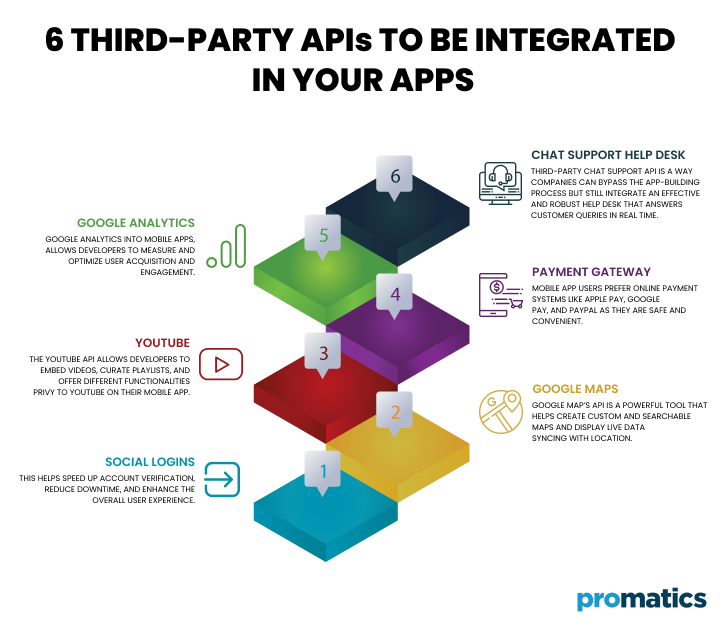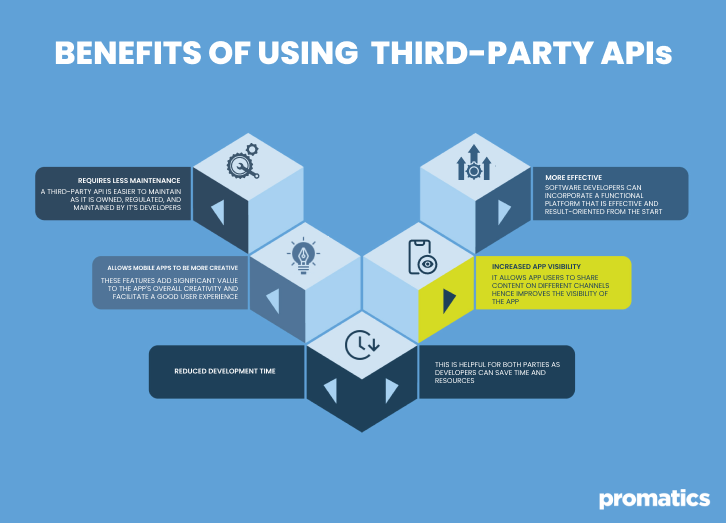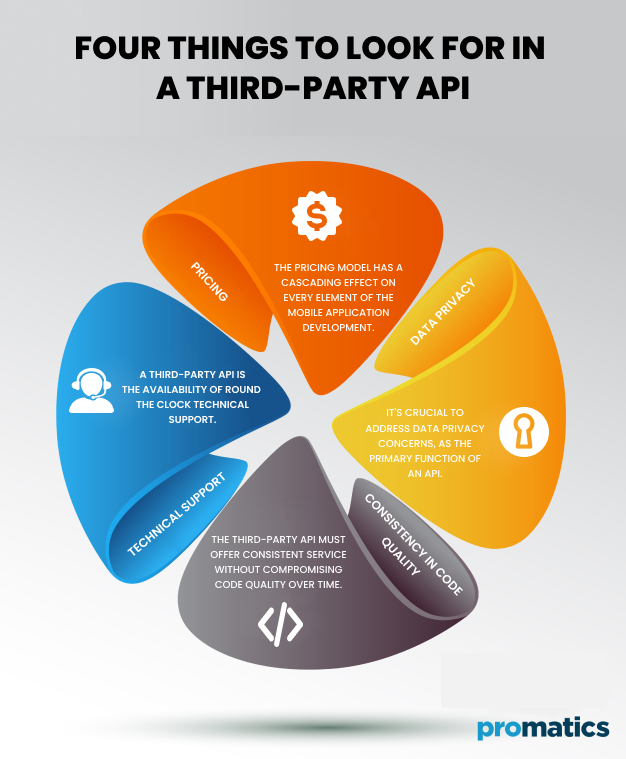The Most Essential Third-party APIs You Should Get Integrated Into Your Mobile App
Mobile app development is a time-consuming task, as it requires a lot of patience and precision to bring a flawless and efficient app to the table. The downside of dedicating substantial time to developing a mobile app is the increased process cost. Fortunately, integrating third-party APIs is the best way to curb expenses and minimize development time.
For many users, it’s the front end of the mobile app that is exciting. While it is true that the app’s design and look-and-feel have a major impact on adoption and usage, it’s really the back-end processes that make the app a success. The app’s true value lies in what it delivers to the user and what the user can do with it. The accessibility and manageability of data is the determining factor that makes any mobile app a winner.
APIs allow an enterprise to extend beyond its limitations by offering quick integration and rapid delivery methods. As user skills have become more sophisticated, their capabilities and demands have shifted. This increases the pressure on mobile app developers to satisfy users with an app experience that is seamlessly and effectively integrated.
What is an API?
Let’s go over the basics first. An API stands for Application Programming Interface, which is software that enables two applications to interact with each other. It is a set of protocols, processes, and tools that allow one app to connect with another and transmit data with another software, OS, or third-party service.
What is a third-party API?
A third-party API is a program that connects functionalities from different apps. It is usually offered by large enterprises that allow a mobile app to access their software utilities and data on your application.
One example of a third-party API can be seen when a ride-booking app, like Uber, integrates a Map functionality from Google Maps to track rides. Using Google’s established map platform allows Uber developers to save time that would otherwise be spent on building the same service from scratch.
How does a third-party API work?
A third-party API is a reusable communication medium between two apps. It allows both parties to create shared functionalities and facilitate regulated data sharing. Companies that enable others to use their server to access data develop a unique app utility as an API that other apps can plug into their own app features. The same company also makes an integration code public, along with instructions regarding its implementation.
Top APIs you should integrate into your app
We use different mobile apps daily that effortlessly integrate various services’ functionalities. The quicker and more efficient your user experience is, the higher the chances of repeat usage. But have you ever wondered how these mobile apps could deliver on so many fronts? Do the app developers work on each element from scratch?
The answer is third-party APIs which allow developers to integrate the functionality of other apps into their own. It saves time and cost of developing the same utility in-house and enables small setups to use the services of more established providers.
It has been observed that mobile app developers often need help with identifying a suitable third-party API for their apps. Here are our top 7 picks for third-party APIs that you should integrate into your app for optimum user experience.
1. Social Logins
According to a survey, over 86% of web users don’t appreciate creating new accounts when they visit a new page. Therefore, integrating social platforms with your mobile app gives developers a chance to retain visitors. After all, the success of an app relies on the experience you offer the users in terms of logins, access, usage, email verification, and more.
Creating new accounts takes time, and many users choose to uninstall an app if they have to feed all their personal information to make a new account from scratch. To avoid this situation, mobile apps implement social logins instead of featuring self-curated submission forms. This helps speed up account verification, reduce downtime, and enhance the overall user experience.
One of the most famous social platforms that mobile app developers integrate through API is Facebook. It allows developers limited access to the profile identity of Facebook members to verify their login. The Facebook API also enables users to post content to their News Feed from third-party apps they’re using.
Similarly, other apps like Twitter and LinkedIn also offer third-party APIs that mobile apps can use for quick user verification and login.
2. Google Maps
Everyone knows about the search giant Google and its commitment to providing an outstanding customer experience. Google Maps is a highly popular API that many mobile apps include in their offering to take their app up a few notches.
Google Map’s API is a powerful tool that helps create custom and searchable maps and display live data syncing with location, check-in features, and plan routes, to name a few. Whether a user is looking for a satellite image of a place, the shortest way to get there, or current traffic conditions, Google Maps is a complete platform that provides various useful utilities under a single banner.
This API is the most favored geolocation API in Android and iOS devices. From ride-hailing apps to retail stores and online games, Google Maps is used across several industries. Adding this third-party API to your mobile app gives you an edge over other competitors and allows you to benefit from the established expertise of Google’s app.
3. Chat Support Help desk
Chat APIs have become increasingly popular over the years because of their ease and convenience to digital applications. Real-time chat support is crucial to engage with customers during a sales process, but building chat applications with real-time messaging, file sharing, video chat, etc., can be costly. Besides requiring many months of planning and development work, it also needs considerable technical expertise.
Third-party chat support API is a way companies can bypass the app-building process but still integrate an effective and robust help desk that answers customer queries in real-time. Here is a curated list of most popular video chat APIs.
Real-time communication has transformed the business world and developers today understand the relationship between immediate connections with growth and productivity. Therefore, integrating voice, video, and chat functionality with pre-made software is a smart solution that saves developers the cost of in-house development and delivers immediate customer satisfaction.
4. Payment Gateway
As the world is fast approaching a cashless future, the facility of instant and secure transactions is a user demand that is hard to ignore. Mobile app users prefer online payment systems like Apple Pay, Google Pay, and PayPal as they are safe and convenient. So if you are developing a mobile app or an MVP, integrating third-party Payment gateway API is an investment worth every penny.
Users prefer payment gateways because wallet and card payments solve several pain points. It saves them from the hassle of dealing in cash and facilitates the full utilization of discounts and coupons. Integrating a third-party API for payments means the gateway is accompanied by robust and unbreakable security that makes the possibility of fraud and security breaches almost impossible.
A payment gateway is essential to a mobile app if any in-app purchases are involved, but developing a robust payment system requires significant expertise and resources. Therefore, integrating a third-party payment gateway API is a less costly way to achieve the same results.
5. Google Analytics
Yet another powerful API from Google, integrating Google Analytics into mobile apps, allows developers to measure and optimize user acquisition and engagement. This third-party API enables developers to identify the number of users in the app, their characteristics, and their location. It also helps them understand their users’ actions, which ultimately shows them where they need to focus.
With the Google Analytics API, visualizing user navigation paths becomes possible, and so does segmenting your app data to understand different user groups’ behavior. Developers can integrate this third-party API to customize the data or fields for the analytics of their mobile application. It can even be used to set various campaigns for your app according to demographics and specific keywords.
With Google Analytics, you can receive detailed insights about how each of your campaigns is performing and how users are responding to it. As Google Analytics API collects, analyzes, and customizes data, this cross-platform app API is very valuable for the success of a mobile app.
6. YouTube
The YouTube API allows developers to embed videos, curate playlists, and offer different functionalities privy to YouTube on their mobile app. The API makes it possible for mobile developers to provide advanced video-sharing features on their app without writing the code from scratch.
Incorporating third-party YouTube API means taking advantage of existing content without spending valuable resources on creating something new. In addition, YouTube is among the top social media platforms, with over two billion active users spread across 100 countries. As the leading video streaming app, YouTube’s API is immensely valuable from a conversion rate and revenue standpoint.
When you integrate this third-party API into your application, you can benefit from YouTube analytics and easily track numbers directly from app visits. Moreover, the server load time on your app is also reduced since the video remains hosted on YouTube.
Benefits of using third-party APIs
Designing and developing a stellar app requires several moving parts, and with the rising expectations of modern users, developers are always on the lookout for ways to enhance customer experience. Third-party APIs enable app creators to offer users advanced functionalities without incurring the high costs accompanying them.
Here are the top benefits of third-party APIs for mobile app developers.
a. Reduced development time
With so many valuable APIs available in the market, mobile apps can easily connect with third-party service providers to meet different needs. For example, a developer has to design a log-in module to verify users in mobile apps. Instead of writing the code from scratch, they can use Facebook sign-in API, Google sign-in API, etc.
This is helpful for both parties as developers can save time and resources while users can enjoy quick log-ins using their saved Google or Facebook sign-in credentials.
b. Allows mobile apps to be more creative
App developers usually try to limit functionalities and features to a minimum because of time and resource constraints. While trying to restrict the features, they end up compromising the app’s creative ability. Integrating third-party APIs ensures that your mobile app can have all the components that are challenging to develop on your own. These features add significant value to the app’s overall creativity and facilitate a good user experience.
c. Increased app visibility
When you incorporate third-party APIs such as Whatsapp API, LinkedIn API, Facebook API, Twitter API, etc., you are giving users the opportunity to share information. As app users share content on different channels, it effectively improves the visibility of your app on other media. For example, a News app user shares the app’s content on other channels. If the content matches the user’s expectations, it will attract more people and increase the app’s download rate.
d. More effective
Using a third-party API in your mobile app means drawing on the other app’s expertise and benefiting from its established presence in the market. Building all the features from scratch means there will be some trial and error and an unavoidable learning curve. However, using a third-party API means software developers can incorporate a functional platform that is effective and result-oriented from the start.
e. Requires less maintenance
A third-party API is easier to maintain as it is owned, regulated, and maintained by the organization that develops it. If you select third-party APIs from reliable companies, you will have no problems with maintenance, as updates will occur seamlessly without any effort on your part.
How to choose the right third-party API for your mobile application
Selecting a third-party API is a challenging feat, as your decision impacts the functionality and scalability of your app in the future. In the case of a faulty API, the primary services of your application may be affected, ruining the end user’s experience.
Several service providers offer similar kinds of APIs, but you should always go for one that has a solid reputation and is known for its seamless user experience. Before you select a vendor, research thoroughly on your end to avoid any last-minute surprises. Gather all the data from outage frequency to after-sales service records to help you make an informed decision.
Developers must consider a few factors when choosing a third-party API.
i. Pricing
The pricing model has a cascading effect on every element of the mobile application development process. While most organizations opt for the API with the lowest price, it’s not always a wise decision if you consider higher volume usage. You can always start with the pricing plan that fits your budget and eventually negotiate with the API vendor when you need to scale the app.
ii. Data Privacy
It’s crucial to address data privacy concerns, as the primary function of an API is to facilitate the transfer of data from your application to a remote server. When selecting a third-party API for integration into your app, you must conclude how robust the vendor’s privacy policy is and whether the communication between your app and the API vendor is secure enough.
iii. Consistency in Code Quality
The third-party API must offer consistent service without compromising code quality over time. If there’s a lack of reliability, it may jeopardize your mobile application completely.
iv. Technical Support
Another critical aspect when selecting a third-party API is the availability of round-the-clock technical support. From implementation questions to outage updates, integration, and error support, unfailing technical support helps the end-users and developers get quick answers when they need them.
Conclusion
When a mobile app works with a third-party API, they not only benefit from its strengths and merits but also inherits its weaknesses and bad practices. Therefore, it’s imperative to select external APIs after weighing all their pros and cons.
Mobile apps are evolving and improving rapidly; new technologies are making them more creative, productive, and effective. API integration allows developers to deliver more with little coding and power their apps with critical functionalities that are difficult to achieve in-house.
Still have your concerns?
Your concerns are legit, and we know how to deal with them. Hook us up for a discussion, no strings attached, and we will show how we can add value to your operations!



